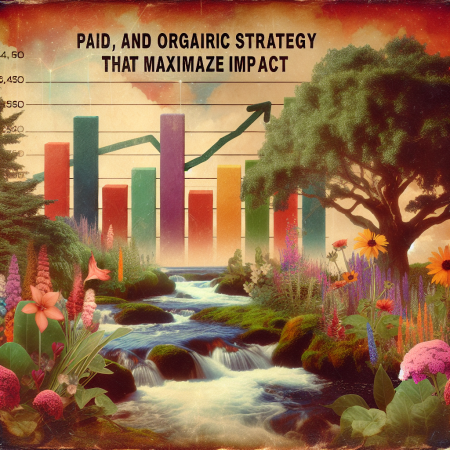The Paid and Organic Hybrid Strategy That Maximizes Impact
Understanding the Basics of Hybrid Strategies
What is a Hybrid Strategy?
When I first heard about hybrid strategies in marketing, I was honestly a bit confused. It sounds so fancy, right? Essentially, a hybrid strategy combines both paid advertising and organic methods to create a well-rounded approach. What I’ve found is that leveraging both can really maximize your impact on your audience.
The charm lies in how paid ads can produce immediate results, allowing you to boost visibility, while organic strategies build more sustainable, long-term growth. By merging the two, businesses can optimize their reach while still nurturing those valuable relationships with their customers.
It’s like having two powerful engines driving your marketing ship! That’s why understanding the balance between these strategies is crucial. Getting the hang of this combo can truly transform how you connect with your audience.
Crafting Your Paid Advertising Strategy
Getting Started with Paid Ads
So, you’re ready to dive into the world of paid advertising? Awesome! My journey began with setting clear objectives. What do you want to achieve—brand awareness, lead generation, or something else? Defining your goals helps you tailor your approach right from the get-go.
Next up, selecting the right platforms is key. Depending on your audience, certain platforms like Facebook or Google Ads may serve you better than others. I like to think of it as meeting your audience where they’re hanging out. If they’re scrolling on Instagram, you better be right there with them!
Budgeting is another important consideration. Start small and scale as you see results. I’ve learned, through trial and error, that sometimes it’s better to invest a little less initially to test the water before diving in headfirst. This way, you can learn what works best without breaking the bank.
Optimizing Your Organic Presence
Building a Strong Content Strategy
Now, let’s switch gears to organic strategies. Content creation has been a game changer for me. I always emphasize the power of storytelling and engaging content. It’s not just about hitting keywords; it’s about relating to your audience. Invest time in understanding what they genuinely care about.
Next, consistency is everything. Whether it’s blogging, video content, or social media posts, showing up regularly helps build trust and keeps your brand top of mind. It’s like having a friendly neighbor who’s always around – people will think of you when they need something!
Don’t forget about SEO! Learning the ins and outs of search engine optimization significantly boosts your organic reach. Using the right keywords and optimizing your content really pays off in the long run. I’ve seen my own traffic skyrocket just by tweaking a few on-page elements.
Leveraging Data for Better Decision-Making
The Importance of Analytics
Data doesn’t lie! I’ve come to rely heavily on analytics to guide my strategies. By tracking how my paid and organic efforts perform, I can see what’s resonating with my audience and where I need to pivot. Diving into Google Analytics or social media insights gives me that clarity.
You shouldn’t wait until the end of a campaign to assess performance. I like to check in regularly to measure metrics like engagement, clicks, and conversions. This allows me to fine-tune my approach in real-time, maximizing my efforts and minimizing waste.
Moreover, data isn’t just for showing off results; it’s also informative for future campaigns. Learning from what did or didn’t work last time can inform my next steps. Every mistake is just a stepping stone on the path to success!
Creating a Seamless Integration
Bringing Paid and Organic Together
Honestly, integrating your paid and organic strategies is where the magic happens. It’s not enough to just run ads and create content in a vacuum. I believe they should complement each other seamlessly. For example, using keywords from your paid campaigns in your organic content can drive better visibility across the board.
Additionally, guidance from paid campaigns can help you understand what topics resonate well, allowing your organic strategy to evolve. Always be on the lookout for new keywords or topics that pop, and don’t hesitate to shift your focus based on what the data tells you!
Ultimately, it’s about creating a cohesive brand message. Whether someone sees your ad or reads a blog post, they should get a consistent experience that builds recognition and trust. This integrated approach pays off big time, as you’ll likely see improved engagement and conversion rates.
Frequently Asked Questions
1. What are the main benefits of combining paid and organic strategies?
Combining both strategies can amplify reach and visibility quickly while nurturing long-term relationships through organic content, leading to sustainable growth.
2. How should I measure the success of my hybrid strategy?
Use analytics tools to track metrics like clicks, conversions, and engagement for both paid and organic efforts. Regularly assessing this data can inform ongoing adjustments.
3. Can I run a hybrid strategy on a tight budget?
Absolutely! Start small with both paid ads and organic content, and grow your investment as you see what works best for your audience.
4. How can I create content that resonates with my audience?
Engage with your audience through surveys and feedback. Understanding their needs and interests will allow you to craft tailored, relatable content.
5. What’s the best way to split my focus between paid and organic methods?
It really depends on your specific goals and resources. Many businesses find success with a balanced approach, but testing different ratios can help you find the sweet spot for your brand.


